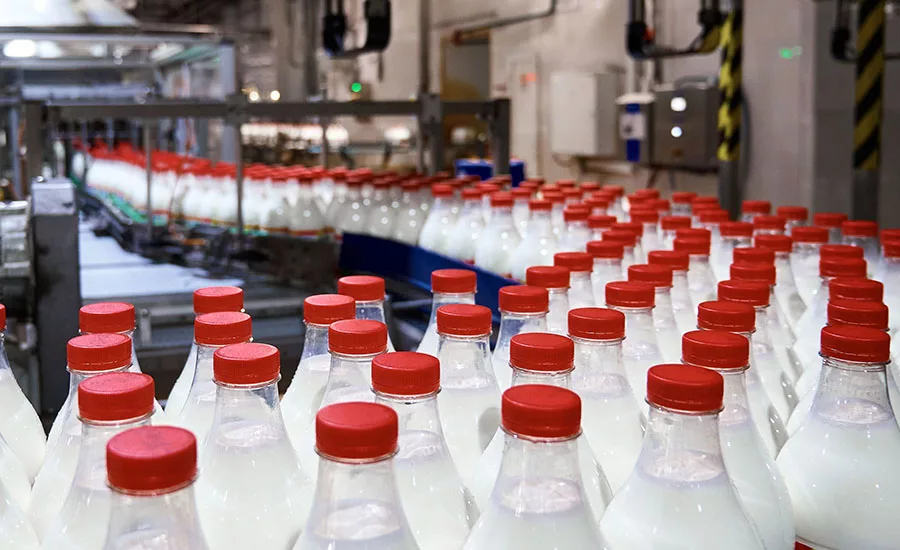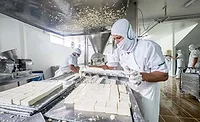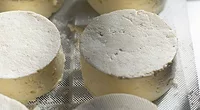The Use of UV-C Light in Combination With Hydrogen Peroxide to Disinfect Packages in ESL and Aseptic Beverages
The need for packaging materials that preserve the quality of products while preventing microbial contamination has become a critical focus for the beverage and dairy industries

Image credit: Nordroden/iStock/Getty Images Plus via Getty Images
In the ever-evolving world of food processing, the demand for products with longer shelf life has driven the development of advanced packaging and sterilization technologies. The need for packaging materials that preserve the quality of products while preventing microbial contamination has become a critical focus for the beverage and dairy industries, particularly for extended shelf life (ESL) and aseptic beverages. One of the most promising solutions in this area is the combination of ultraviolet-C (UV-C) light and hydrogen peroxide (H₂O₂) for disinfecting packaging materials.
This article delves into the role of UV-C light and H₂O₂ in the sterilization process of packaging materials used in ESL and aseptic beverages, exploring the benefits, challenges, and the future of these technologies.
Introduction to ESL and Aseptic Beverages
Before understanding how UV-C light and H₂O₂ work together to disinfect packaging materials, it is essential to comprehend the processes behind ESL and aseptic beverage production.
Extended Shelf Life (ESL) Beverages
Extended shelf life beverages, especially milk, fruit juices, and dairy alternatives, have seen a significant increase in demand due to their convenience and longer freshness. ESL refers to beverages that have been treated to reduce the microbial load beyond traditional pasteurization, thus extending their shelf life while maintaining a fresh taste.1,2
One method of achieving ESL is ultra-pasteurization, which involves heating milk or dairy products to temperatures exceeding 138 °C (280 °F) for at least 2 seconds.3 This process ensures that spoilage microorganisms and their spores are eliminated, while preserving the product's sensory qualities (Figure 1).

ESL beverages require packaging that prevents recontamination and maintains sterility. The packaging process must be carried out in a highly controlled environment to avoid microbial growth after pasteurization.
Looking for quick answers on food safety topics?
Try Ask FSM, our new smart AI search tool.
Ask FSM →
Aseptic Processing and Packaging
Aseptic packaging is a method used to sterilize both the product and the packaging material. It is particularly effective for products that need to be stored at ambient temperatures for extended periods of time without refrigeration.4
The product undergoes sterilization, typically through ultra-high temperature (UHT) or sterilization techniques, followed by filling into sterile containers in a microbiologically controlled, sterile environment. After sterilization and filling, the containers are sealed to ensure that no microorganisms can enter, thus allowing the product to stay uncontaminated for months or even years, depending on the product.5
Both ESL and aseptic beverages rely heavily on the sterilization of packaging materials to ensure product safety and quality.
The Role of Hydrogen Peroxide in Sterilization
H₂O₂ has been widely used as a disinfectant and sterilizing agent in the food industry for several decades. It is particularly favored for sterilizing packaging materials, especially in aseptic and ESL beverage applications, due to its broad-spectrum antimicrobial properties.
Hydrogen Peroxide as a Microbial Agent
Hydrogen peroxide is a powerful oxidizer, meaning it can destroy microorganisms by breaking down their cell structures. It works through the following mechanisms:
- Generation of reactive oxygen species: Hydrogen peroxide decomposes into water and oxygen under certain conditions, but during this process, it generates reactive oxygen species (ROS), such as hydroxyl radicals (OH·), which are highly destructive to microbial cells. These ROS attack the cell membranes, proteins, and DNA of the microorganism, leading to cell death.
- Bactericidal effect: The bactericidal effect of H₂O₂ is well-documented. It is effective against a wide range of bacteria, viruses, yeasts, and molds. For packaging sterilization, hydrogen peroxide is typically used in concentrations of 35 percent, and then dried using hot air to ensure that any residual chemical content does not affect the product. Residual H₂O₂ must be less than 0.5 ppm, per U.S. Food and Drug Administration (FDA) regulations.
Advantages of H₂O₂ for Packaging Sterilization
H₂O₂ has several advantages when used for sterilizing packaging materials:
- Effectiveness: H₂O₂ is capable of achieving a high degree of microbial reduction, particularly in difficult-to-sterilize spores like Bacillus subtilis, which are often used in validation studies.
- Environmentally friendly: As H₂O₂ breaks down into water and oxygen, it leaves no harmful chemical residues behind, making it an environmentally friendly alternative to other sterilizing agents.
- Safety: Unlike some chemicals that may require hazardous handling or pose a health risk to workers, H₂O₂ is relatively safe when used in controlled concentrations and environments.
UV-C Light and Its Role in Sterilization
UV light, particularly UV-C light (wavelengths from 200–280 nm), is widely known for its antimicrobial properties. It is a non-chemical method of disinfecting surfaces and is increasingly being used in the food industry for sterilizing both products and packaging materials.
How UV-C Light Works
UV-C light sterilizes by damaging the DNA or RNA of microorganisms:
- DNA/RNA damage: When microorganisms are exposed to UV-C light, the UV radiation causes the formation of pyrimidine dimers in the DNA or RNA, leading to mutations that prevent the organism from replicating and functioning normally.
- Inactivation of microorganisms: The result is that microorganisms are rendered inactive, which prevents them from growing or causing contamination.
UV-C Light for Packaging Sterilization
UV-C light is an effective tool for sterilizing packaging materials in both ESL and aseptic beverage applications. It primarily works on the surface of materials, making it ideal for disinfecting packaging surfaces without affecting the product itself. Packaging materials such as glass, plastic, and metal can be effectively sterilized using UV-C light (Figure 2).

One of the main benefits of UV-C sterilization is that it does not involve any chemicals, making it a safer and more sustainable option than some other sterilization methods.
Synergistic Effect of UV-C Light and H₂O₂
The combination of UV-C light and H₂O₂ for sterilizing packaging materials in ESL and aseptic beverages is gaining attention for its synergistic bactericidal effects. The synergistic effect is primarily based on the ability of UV-C light to activate H₂O₂, which, in turn, enhances its disinfectant properties:
- Activation of Hydrogen Peroxide: When hydrogen peroxide is exposed to UV-C light, it breaks down into highly reactive radicals, such as hydroxyl radicals (OH·). These radicals are even more effective at disrupting the cell structure of microorganisms.
- Enhanced Bactericidal Activity: This combination increases the bactericidal efficacy of hydrogen peroxide, allowing for more effective sterilization at lower concentrations of hydrogen peroxide, thus reducing chemical usage and costs.
Validation Studies and Results
Several studies have confirmed the effectiveness of this combined approach. Leading aseptic packaging providers conducted validation studies that demonstrated a 5-log reduction (99.999 percent) in Bacillus subtilis spores using a combination of UV-C light and H₂O₂. This level of microbial reduction is critical for ensuring the safety of the packaging and, by extension, the product inside.
The synergistic effects of UV-C light and H₂O₂ offer several benefits:
- Lower chemical concentrations: By using lower concentrations of H₂O₂, the cost and handling requirements of the chemical are minimized. It also reduces the environmental impact associated with high concentrations of chemicals.
- Reduced residue levels: The combination of UV-C light and H₂O₂ also helps ensure that the packaging is thoroughly dried, leaving very little to no chemical residue. Regulatory standards, such as those set by FDA (less than 0.5 ppm), are easily met.
Alternative Methods of Packaging Sterilization
While the combination of UV-C light and H₂O₂ is highly effective, it is not the only method available for sterilizing packaging materials. Several alternative methods are used in the food and beverage industry, depending on the nature of the product and packaging.
Peracetic Acid and H₂O₂
In some cases, particularly with heat-sensitive plastic packaging (e.g., PET bottles), peracetic acid can be used in combination with H₂O₂ for sterilization. This method is effective for disinfecting packaging materials without the need for high heat, which could damage the packaging.
Electron Beam and Gamma Irradiation
Electron beam (e-beam) irradiation and gamma irradiation are other sterilization methods that have been explored, particularly for packaging. However, these methods are often more expensive and may pose safety concerns due to radiation exposure. As a result, they are less commonly used in commercial filling operations.
Future Trends in Packaging Sterilization
As food safety standards continue to evolve and consumer demand for more sustainable and efficient practices increases, packaging sterilization technologies will continue to be developed. Future trends include:
- Chemical-free sterilization: Technologies such as cold plasma, ozone, and high-pressure processing (HPP) are being explored as potential alternatives to chemical-based sterilization methods.
- Smart packaging: Future packaging materials may include sensors or radio frequency identification (RFID) technology to monitor the condition of the product throughout its shelf life. This could allow for better management of inventory and product freshness.
- Sustainability: There is an increasing focus on developing eco-friendly packaging materials and sterilization techniques that minimize waste and reduce the carbon footprint of food and beverage production.
Takeaway
The use of UV-C light in combination with hydrogen peroxide for disinfecting packaging materials has proven to be an effective and efficient method for sterilizing packaging in ESL and aseptic beverages. This innovative approach provides a synergistic bactericidal effect that significantly enhances microbial control, reduces chemical usage, and meets regulatory safety standards.
As the demand for longer shelf life and improved food safety continues to grow, the combination of UV-C and H₂O₂ will play an essential role in the future of beverage packaging. Additionally, emerging technologies may offer even more sustainable and cost-effective solutions, helping ensure the continued safety, quality, and environmental sustainability of food and beverage products.
References
- Rysstad, G. and J. Kolstad. "Extended shelf life milk—advances in technology." International Journal of Dairy Technology 59, no. (May 2006).
- Singh, R., G. Rathod, G. H. Meletharayil, R. Kapoor, V. M. Sankarlal, and J. K. Amamcharla. "Invited review: Shelf-stable dairy protein beverages—Scientific and technological aspects." Journal of Dairy Science 105 (2022): 9327–9346. https://doi.org/10.3168/jds.2022-22208.
- National Conference for Interstate Milk Shipments. "Grade 'A' Pasteurized Milk Ordinance (PMO): 2023 Revision." 2023. https://ncims.org/wp-content/uploads/2024/08/2023-pmo.pdf.
- Sanjana, M.C., R. Hemegowda, and R.E. Sushma. "Aseptic Packaging—A Novel Technology to the Food Industry." International Journal of Trend in Scientific Research and Development 3, no. 3 (2019): 2456–6470.
- Code of Federal Regulations. Title 21, Chapter I, Subchapter B, Part 113. "Part 113—Thermally Processed Low-Acid Foods Packaged in Hermetically Sealed Containers." March 16, 1979. Last amended February 3, 2025. https://www.ecfr.gov/current/title-21/chapter-I/subchapter-B/part-113.
Srinivasarao Bandla, M.S., PCQI is a recognized food safety professional who currently works as a Quality Assurance Manager at Land O'Lakes. He has worked in quality assurance and food safety roles at globally renowned dairy manufacturing companies, partnering with research and development and other stakeholders to deliver safe, high-quality dairy products to consumers. His research interests include UV-C light uses in food packaging and food safety in dairy manufacturing. Mr. Bandla has conducted research on the design of a UV-C coiled tube reactor and evaluated its nutritional and shelf-life impact on milk processing, and has published his research findings in four publications. He has also completed 15 peer reviews related to UV-C light processing and dairy products for various food science journals. Mr. Bandla completed his M.S. degree in Food Science and Agriculture Systems at Southern Illinois University–Carbondale in December 2010 and a B.Tech. degree in Dairy Science at SVVU in August 2007.








